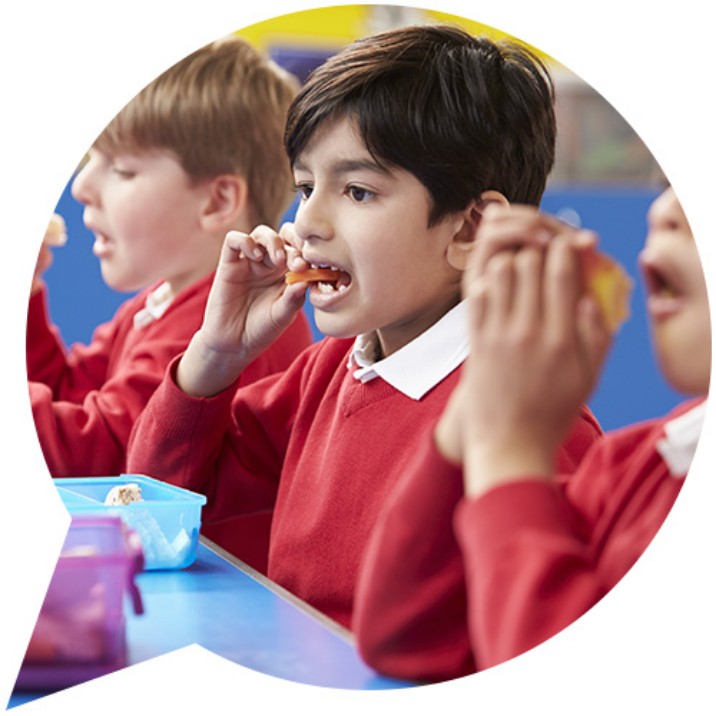Healthy Eating
What children eat during childhood can influence their future eating habits, weight and health for life. A balanced and varied diet with plenty of fruit and vegetables is vital for energy, brain function, growth and development.
Parents’ Voice Aims to:

Make selecting and purchasing healthy food options for kids easy.

Reduce the presence of unhealthy food and beverages in places that kids spend most of their time (home, school, sports clubs, restaurants and retail outlets).

To take the stress out of family meal times and grocery shopping with kids by providing tips from parents and experts
Healthy Lunchbox
Encourage your children to be involved in the selection and preparation of their lunch.
When our kids are involved in food preparation they are more likely to experiment with different types of foods.
A bit of imagination goes a long way when it comes to making lunches appealing and interesting.
Try to include the following foods in your child’s daily lunchbox:
- Fresh fruit
- Crunchy vegetables
- A dairy food – cheese, milk or yoghurt
- A protein food – slice of lean meat, hard boiled egg or peanut butter (beware of nut policies)
- Grainy food – wholegrain bread, a roll, flat bread, fruit bread or crackers
- Water
Tips from parents
- For small children keep serves small and cut-up wherever possible.
- Sandwiches can be prepared and pre-cut the night before or on the weekend, frozen then taken for each day’s lunchbox. Suitable fillings that can be frozen include cooked lean meat, reduced-fat cheese, baked beans or Vegemite. Defrost in the fridge overnight and add salad in the morning.
- Cut up veggie sticks the night before when cutting up the vegetables for dinner and put in a tub ready for the lunchbox.
- Stop the sandwiches from going soggy by placing tomato between the lean meat, reduced-fat cheese or lettuce.
- Cut sandwiches into different shapes such as triangles or fingers.
- Ask your child to list their top 10 sandwich fillings or put the list on the fridge. This will help if you are stuck one morning and need to make something in a hurry.
- To introduce your child to wholemeal or wholegrain bread why not try zebra pattern – ½ white ½ wholemeal sandwiches.
- Ensure you vary the items to keep your child interested in food and to prevent boredom.
Tips for a healthy lunchbox
There are many resources available if you’re looking for easy, fun and efficient lunchbox recipes for the kids. Here are some of our favourites, but please tell us if you find others that should be included here!
Lunch planners
For those of you who like to (or have time to!) plan, here are some free planners
- Your kids can fill this one in at the Great Grub Club.
- Lunchbox – Menu Planner from Better Health
How to pack a healthy lunchbox 101!
Check out Nutrition Australia for some useful lunchbox tips or visit the Cancer Council’s ‘Healthy Lunch Box’ page, for a handy interactive guide and some quick and easy recipes.
Healthy lunch recipes
- Healthy lunchbox snacks from the Healthy Kids Association
- Healthy lunchbox meals from Kidspot
- The Women and Children’s Network have a child friendly section of recipes
Feeding your family
What children eat during childhood can influence their future eating habits, weight and health for life. A balanced and varied diet with plenty of fruit and vegetables is vital for energy, brain function, growth and development.
It’s challenging for us as parents to consistently provide healthy food that is interesting and appealing to children. It’s no secret that children can be fussy eaters. Their food preferences are influenced by a constant barrage of junk food marketing and an abundance of unhealthy options available in the places that they live learn and play.
Food Labelling
For assistance navigating the labyrinth of food labels take a look at the Foodswitch from Bupa and the George Insitute or Food Tracker from the Obesity Policy Coalition.
Labels, claims and endorsements are used by food companies to highlight and display the information that they want the public to see. Food labels usually focus on the positive elements of the product, but fail to tell the whole story about what is in the food. They are a dynamic marketing tool and enhance the saleability of the foods they are placed on. It is important that consumers are able to interpret the information accurately and read between the lines.
Endorsements and approval stamps may originate from an external organisation such as The Heart Foundation or the Glycemic Index Symbol Program, or they may come from the manufacturer themselves. Most consumers do not understand the full meaning of these endorsements and may make purchasing decisions based on trust rather than knowledge.
Health Star Rating
The Health Star Ratings system was introduced in Australia in 2014 to help make healthy purchasing decisions easier for consumers. This front of pack labelling system gives packaged food and drinks a rating out of five stars to reflect the overall healthiness of a product compared to other similar products. For example if you compare one breakfast cereal to another, the cereal with the higher star rating is the better choice for your family. Keep in mind that a five star product does not supersede fresh fruit and vegetables, these should still form the bulk of a healthy diet for kids.
Ingredients lists
All packaged foods sold in Australia must display an ingredients list. Ingredients must be listed in descending order with the main ingredient (highest weight) listed first and the smallest ingredient last. At a glance you can gain valuable nutrition information just by assessing the content and order of the ingredients listed. For example, if sugar is listed near the start of the list you can be sure that it forms a significant proportion of the food and it is not a healthy option.
Food additives are listed by name or an approved numbering system. Parents with children who have allergies or behavioural responses to particular additives need to be aware of both the name and number of the additives that may affect their children. Food Standards Australia and New Zealand (FSANZ) provide a comprehensive food additives list on their website.
Nutrition claims
Nutrition claims are becoming increasingly common on children’s foods. Current guidelines on what is and isn’t permitted on labels are quite confusing. Claims on foods need to be read very carefully, and always in the context of the ingredients list and Nutrition Information Panel.
- Nutrient claims such as ‘high fibre’ are allowed when the manufacturer can prove that the claim is true (although they are rarely asked to do so).
- Claims of ‘low fat’ are only allowed on products with less than 3g of fat per 100g, BUT claims that state a product is ‘light’ are not subject to the same guidelines. The claim ‘light’ may appear on products with a variety of fat contents.
- The only ‘health claim’ currently permitted on food packages is for folate and the prevention of neural tube defects in babies.
- Some manufacturers may make general health claims about functional benefits like bone or heart health.
- General claims found on children’s foods often refer to energy levels, however manufacturers are unlikely to point out that high energy levels provided by a product are most likely derived from a high sugar content. This is the case with many ‘high energy’ breakfast cereals marketed to children.
The Basics
Everyday Foods
Aim for:
- Plenty of vegetables of different types and colours, and legumes/beans
- Fruit
- Grain (cereal) foods, mostly wholegrain and/or high cereal fibre varieties, such as breads, cereals, rice, pasta, noodles, polenta, couscous, oats, quinoa and barley
- Lean meats and poultry, fish, eggs, tofu, nuts and seeds, and legumes/beans
- Milk, yoghurt, cheese and/or their alternatives, mostly reduced fat however beware of added sugars often found in reduced fat milk and yoghurt (reduced fat milks are not suitable for children under the age of 2 years)
And don’t forget plenty of water to keep hydrated!
Serving size can be a confusing issue.
A serve of fruit is:
- 1 medium piece such as an apple or banana
- 2 small pieces such as apricots or plums
- 1 cup of diced or canned fruit pieces
- ½ cup of pure fruit juice
- 1 ½ tablespoons of sultanas
A serve of vegetables is:
- 75g or ½ cup cooked vegetables
- 75g or ½ cup cooked dried beans, peas or lentils
- 1 cup of salad
- 1 potato
